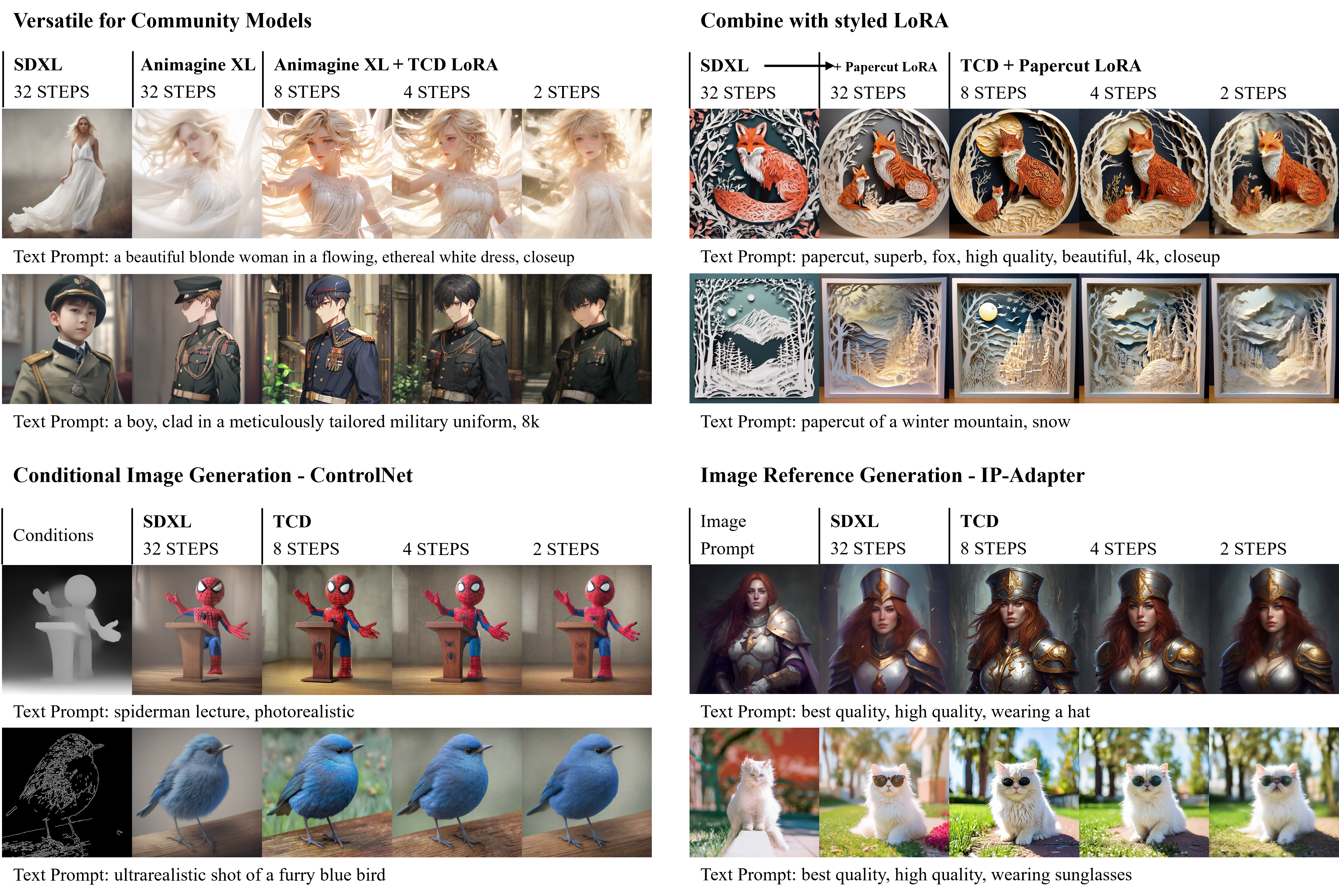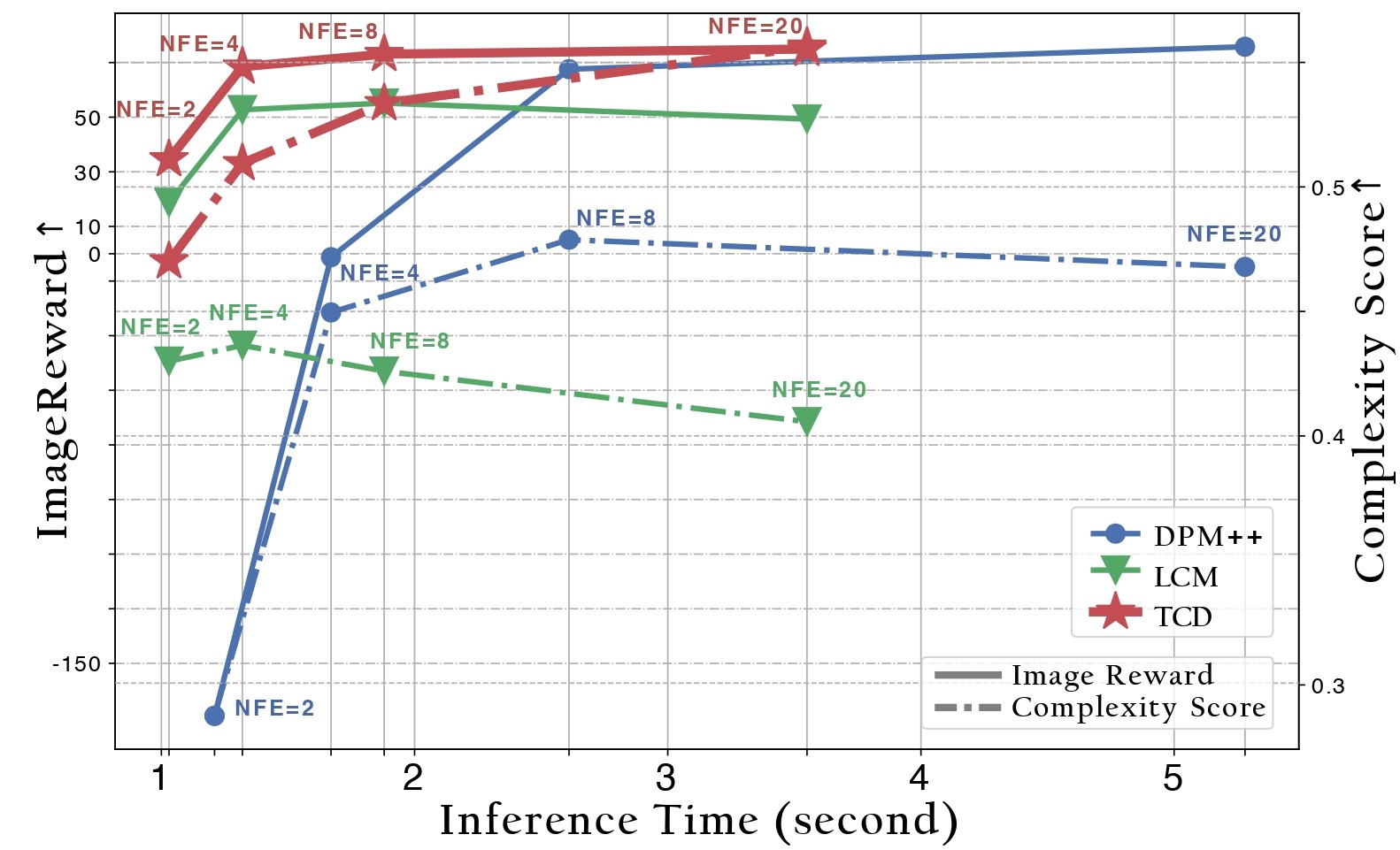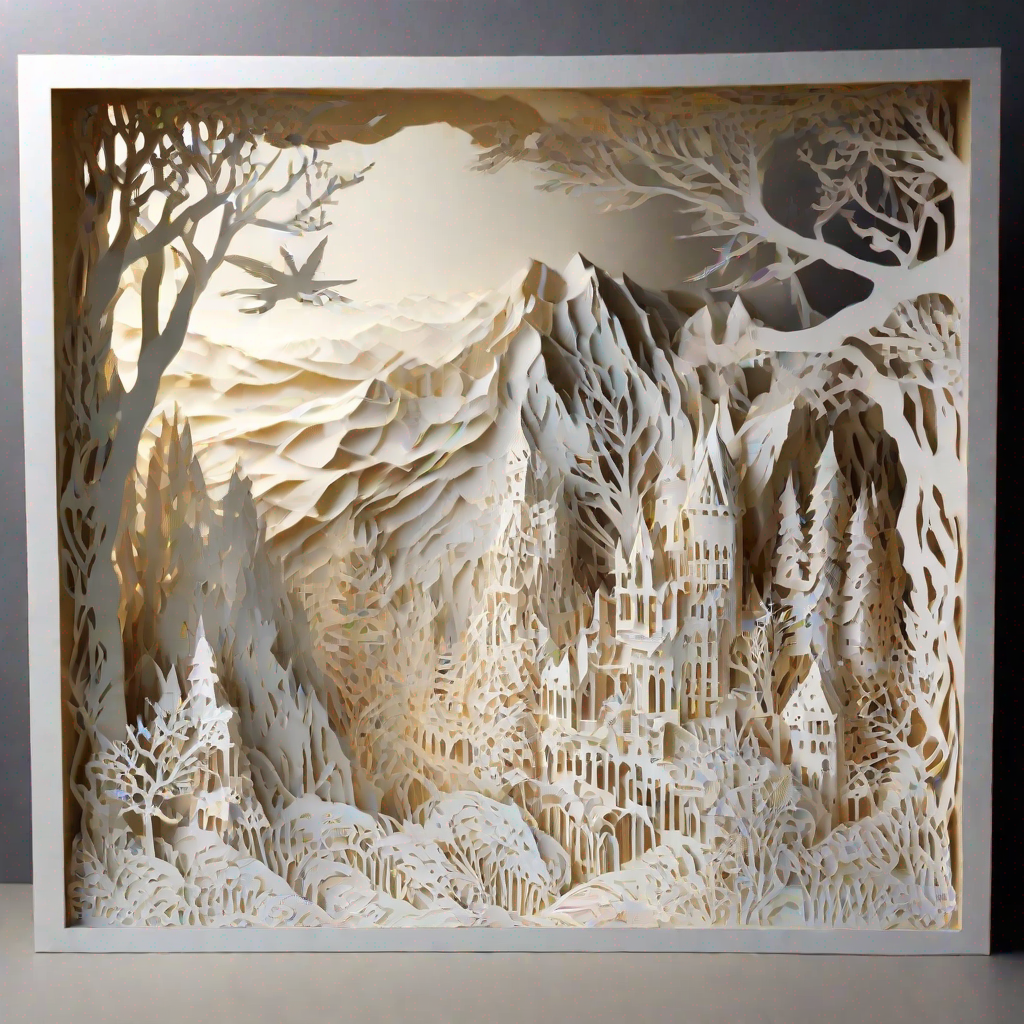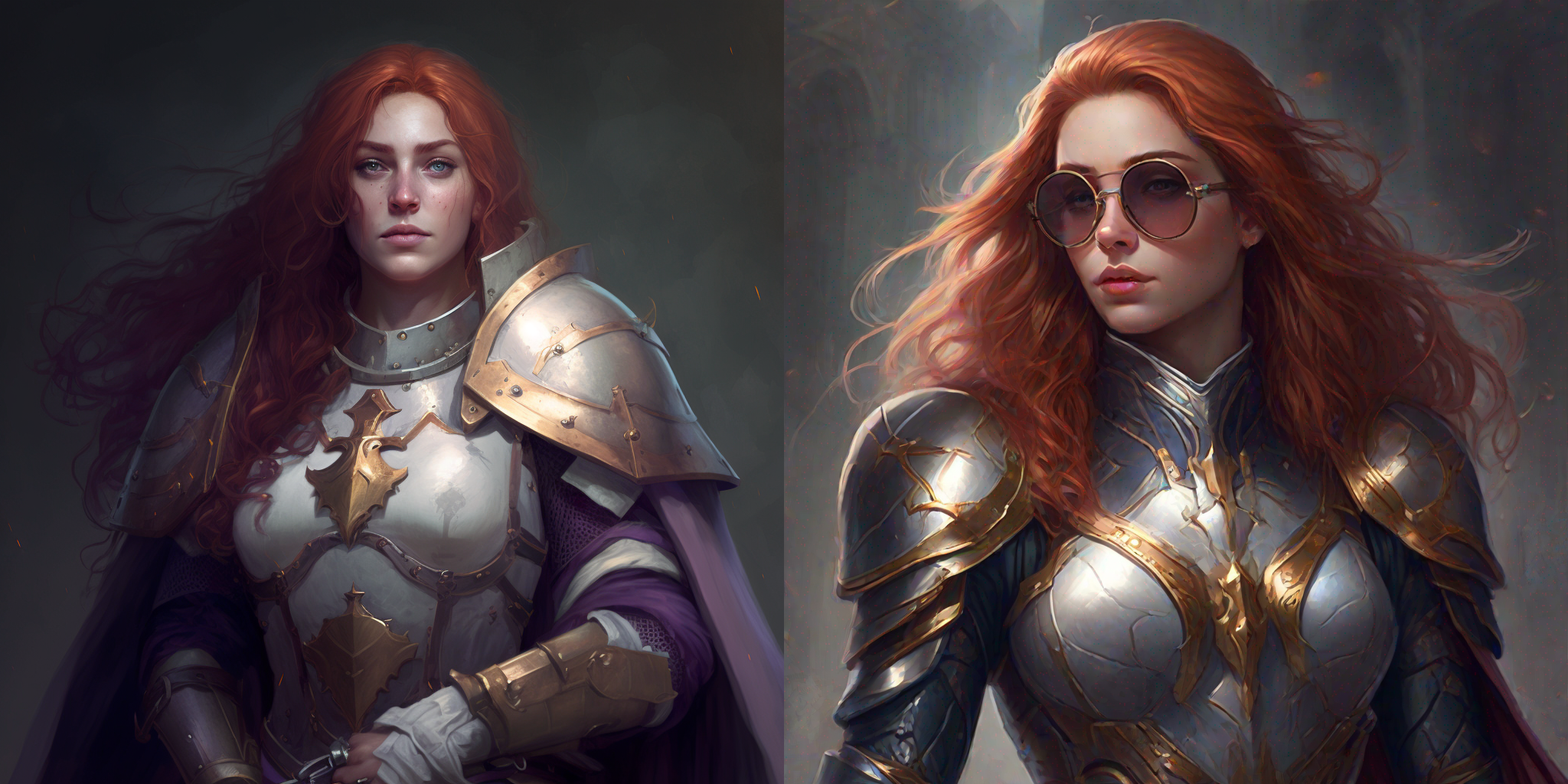Trajectory Consistency Distillation
Official Model Repo of the paper: Trajectory Consistency Distillation. For more information, please check the GitHub Repo and Project Page.
Also welcome to try the demo host on 🤗 Space.
A Solemn Statement Regarding the Plagiarism Allegations.
We regret to hear about the serious accusations from the CTM team.
We sadly found out our CTM paper (ICLR24) was plagiarized by TCD! It's unbelievable😢—they not only stole our idea of trajectory consistency but also comitted "verbatim plagiarism," literally copying our proofs word for word! Please help me spread this. pic.twitter.com/aR6pRjhj5X
— Dongjun Kim (@gimdong58085414) March 25, 2024
Before this post, we already have several rounds of communication with CTM's authors. We shall proceed to elucidate the situation here.
We regret to hear about the serious accusations from the CTM team @gimdong58085414. I shall proceed to elucidate the situation and make an archive here. We already have several rounds of communication with CTM's authors. https://t.co/BKn3w1jXuh
— Michael (@Merci0318) March 26, 2024
In the first arXiv version, we have provided citations and discussion in A. Related Works:
Kim et al. (2023) proposes a universal framework for CMs and DMs. The core design is similar to ours, with the main differences being that we focus on reducing error in CMs, subtly leverage the semi-linear structure of the PF ODE for parameterization, and avoid the need for adversarial training.
In the first arXiv version, we have indicated in D.3 Proof of Theorem 4.2
In this section, our derivation mainly borrows the proof from (Kim et al., 2023; Chen et al., 2022).
and we have never intended to claim credits.
As we have mentioned in our email, we would like to extend a formal apology to the CTM authors for the clearly inadequate level of referencing in our paper. We will provide more credits in the revised manuscript.
In the updated second arXiv version, we have expanded our discussion to elucidate the relationship with the CTM framework. Additionally, we have removed some proofs that were previously included for completeness.
CTM and TCD are different from motivation, method to experiments. TCD is founded on the principles of the Latent Consistency Model (LCM), aimed to design an effective consistency function by utilizing the exponential integrators.
The experimental results also cannot be obtained from any type of CTM algorithm.
5.1 Here we provide a simple method to check: use our sampler here to sample the checkpoint CTM released, or vice versa.
5.2 CTM also provided training script. We welcome anyone to reproduce the experiments on SDXL or LDM based on CTM algorithm.
We believe the assertion of plagiarism is not only severe but also detrimental to the academic integrity of the involved parties. We earnestly hope that everyone involved gains a more comprehensive understanding of this matter.
Introduction
TCD, inspired by Consistency Models, is a novel distillation technology that enables the distillation of knowledge from pre-trained diffusion models into a few-step sampler. In this repository, we release the inference code and our model named TCD-SDXL, which is distilled from SDXL Base 1.0. We provide the LoRA checkpoint in this repository.
✨TCD has following advantages:
Flexible NFEs: For TCD, the NFEs can be varied at will (compared with Turbo), without adversely affecting the quality of the results (compared with LCMs), where LCM experiences a notable decline in quality at high NFEs.Better than Teacher: TCD maintains superior generative quality at high NFEs, even exceeding the performance of DPM-Solver++(2S) with origin SDXL. It is worth noting that there is no additional discriminator or LPIPS supervision included during training.Freely Change the Detailing: During inference, the level of detail in the image can be simply modified by adjusing one hyper-parameter gamma. This option does not require the introduction of any additional parameters.Versatility: Integrated with LoRA technology, TCD can be directly applied to various models (including the custom Community Models, styled LoRA, ControlNet, IP-Adapter) that share the same backbone, as demonstrated in the Usage.
Avoiding Mode Collapse: TCD achieves few-step generation without the need for adversarial training, thus circumventing mode collapse caused by the GAN objective. In contrast to the concurrent work SDXL-Lightning, which relies on Adversarial Diffusion Distillation, TCD can synthesize results that are more realistic and slightly more diverse, without the presence of "Janus" artifacts.
For more information, please refer to our paper Trajectory Consistency Distillation.
Usage
To run the model yourself, you can leverage the 🧨 Diffusers library.
pip install diffusers transformers accelerate peft
And then we clone the repo.
git clone https://github.com/jabir-zheng/TCD.git
cd TCD
Here, we demonstrate the applicability of our TCD LoRA to various models, including SDXL, SDXL Inpainting, a community model named Animagine XL, a styled LoRA Papercut, pretrained Depth Controlnet, Canny Controlnet and IP-Adapter to accelerate image generation with high quality in few steps.
Text-to-Image generation
import torch
from diffusers import StableDiffusionXLPipeline
from scheduling_tcd import TCDScheduler
device = "cuda"
base_model_id = "stabilityai/stable-diffusion-xl-base-1.0"
tcd_lora_id = "h1t/TCD-SDXL-LoRA"
pipe = StableDiffusionXLPipeline.from_pretrained(base_model_id, torch_dtype=torch.float16, variant="fp16").to(device)
pipe.scheduler = TCDScheduler.from_config(pipe.scheduler.config)
pipe.load_lora_weights(tcd_lora_id)
pipe.fuse_lora()
prompt = "Beautiful woman, bubblegum pink, lemon yellow, minty blue, futuristic, high-detail, epic composition, watercolor."
image = pipe(
prompt=prompt,
num_inference_steps=4,
guidance_scale=0,
# Eta (referred to as `gamma` in the paper) is used to control the stochasticity in every step.
# A value of 0.3 often yields good results.
# We recommend using a higher eta when increasing the number of inference steps.
eta=0.3,
generator=torch.Generator(device=device).manual_seed(0),
).images[0]
Inpainting
import torch
from diffusers import AutoPipelineForInpainting
from diffusers.utils import load_image, make_image_grid
from scheduling_tcd import TCDScheduler
device = "cuda"
base_model_id = "diffusers/stable-diffusion-xl-1.0-inpainting-0.1"
tcd_lora_id = "h1t/TCD-SDXL-LoRA"
pipe = AutoPipelineForInpainting.from_pretrained(base_model_id, torch_dtype=torch.float16, variant="fp16").to(device)
pipe.scheduler = TCDScheduler.from_config(pipe.scheduler.config)
pipe.load_lora_weights(tcd_lora_id)
pipe.fuse_lora()
img_url = "https://raw.githubusercontent.com/CompVis/latent-diffusion/main/data/inpainting_examples/overture-creations-5sI6fQgYIuo.png"
mask_url = "https://raw.githubusercontent.com/CompVis/latent-diffusion/main/data/inpainting_examples/overture-creations-5sI6fQgYIuo_mask.png"
init_image = load_image(img_url).resize((1024, 1024))
mask_image = load_image(mask_url).resize((1024, 1024))
prompt = "a tiger sitting on a park bench"
image = pipe(
prompt=prompt,
image=init_image,
mask_image=mask_image,
num_inference_steps=8,
guidance_scale=0,
eta=0.3, # Eta (referred to as `gamma` in the paper) is used to control the stochasticity in every step. A value of 0.3 often yields good results.
strength=0.99, # make sure to use `strength` below 1.0
generator=torch.Generator(device=device).manual_seed(0),
).images[0]
grid_image = make_image_grid([init_image, mask_image, image], rows=1, cols=3)
Versatile for Community Models
import torch
from diffusers import StableDiffusionXLPipeline
from scheduling_tcd import TCDScheduler
device = "cuda"
base_model_id = "cagliostrolab/animagine-xl-3.0"
tcd_lora_id = "h1t/TCD-SDXL-LoRA"
pipe = StableDiffusionXLPipeline.from_pretrained(base_model_id, torch_dtype=torch.float16, variant="fp16").to(device)
pipe.scheduler = TCDScheduler.from_config(pipe.scheduler.config)
pipe.load_lora_weights(tcd_lora_id)
pipe.fuse_lora()
prompt = "A man, clad in a meticulously tailored military uniform, stands with unwavering resolve. The uniform boasts intricate details, and his eyes gleam with determination. Strands of vibrant, windswept hair peek out from beneath the brim of his cap."
image = pipe(
prompt=prompt,
num_inference_steps=8,
guidance_scale=0,
# Eta (referred to as `gamma` in the paper) is used to control the stochasticity in every step.
# A value of 0.3 often yields good results.
# We recommend using a higher eta when increasing the number of inference steps.
eta=0.3,
generator=torch.Generator(device=device).manual_seed(0),
).images[0]
Combine with styled LoRA
import torch
from diffusers import StableDiffusionXLPipeline
from scheduling_tcd import TCDScheduler
device = "cuda"
base_model_id = "stabilityai/stable-diffusion-xl-base-1.0"
tcd_lora_id = "h1t/TCD-SDXL-LoRA"
styled_lora_id = "TheLastBen/Papercut_SDXL"
pipe = StableDiffusionXLPipeline.from_pretrained(base_model_id, torch_dtype=torch.float16, variant="fp16").to(device)
pipe.scheduler = TCDScheduler.from_config(pipe.scheduler.config)
pipe.load_lora_weights(tcd_lora_id, adapter_name="tcd")
pipe.load_lora_weights(styled_lora_id, adapter_name="style")
pipe.set_adapters(["tcd", "style"], adapter_weights=[1.0, 1.0])
prompt = "papercut of a winter mountain, snow"
image = pipe(
prompt=prompt,
num_inference_steps=4,
guidance_scale=0,
# Eta (referred to as `gamma` in the paper) is used to control the stochasticity in every step.
# A value of 0.3 often yields good results.
# We recommend using a higher eta when increasing the number of inference steps.
eta=0.3,
generator=torch.Generator(device=device).manual_seed(0),
).images[0]
Compatibility with ControlNet
Depth ControlNet
import torch
import numpy as np
from PIL import Image
from transformers import DPTFeatureExtractor, DPTForDepthEstimation
from diffusers import ControlNetModel, StableDiffusionXLControlNetPipeline
from diffusers.utils import load_image, make_image_grid
from scheduling_tcd import TCDScheduler
device = "cuda"
depth_estimator = DPTForDepthEstimation.from_pretrained("Intel/dpt-hybrid-midas").to(device)
feature_extractor = DPTFeatureExtractor.from_pretrained("Intel/dpt-hybrid-midas")
def get_depth_map(image):
image = feature_extractor(images=image, return_tensors="pt").pixel_values.to(device)
with torch.no_grad(), torch.autocast(device):
depth_map = depth_estimator(image).predicted_depth
depth_map = torch.nn.functional.interpolate(
depth_map.unsqueeze(1),
size=(1024, 1024),
mode="bicubic",
align_corners=False,
)
depth_min = torch.amin(depth_map, dim=[1, 2, 3], keepdim=True)
depth_max = torch.amax(depth_map, dim=[1, 2, 3], keepdim=True)
depth_map = (depth_map - depth_min) / (depth_max - depth_min)
image = torch.cat([depth_map] * 3, dim=1)
image = image.permute(0, 2, 3, 1).cpu().numpy()[0]
image = Image.fromarray((image * 255.0).clip(0, 255).astype(np.uint8))
return image
base_model_id = "stabilityai/stable-diffusion-xl-base-1.0"
controlnet_id = "diffusers/controlnet-depth-sdxl-1.0"
tcd_lora_id = "h1t/TCD-SDXL-LoRA"
controlnet = ControlNetModel.from_pretrained(
controlnet_id,
torch_dtype=torch.float16,
variant="fp16",
).to(device)
pipe = StableDiffusionXLControlNetPipeline.from_pretrained(
base_model_id,
controlnet=controlnet,
torch_dtype=torch.float16,
variant="fp16",
).to(device)
pipe.enable_model_cpu_offload()
pipe.scheduler = TCDScheduler.from_config(pipe.scheduler.config)
pipe.load_lora_weights(tcd_lora_id)
pipe.fuse_lora()
prompt = "stormtrooper lecture, photorealistic"
image = load_image("https://huggingface.co/lllyasviel/sd-controlnet-depth/resolve/main/images/stormtrooper.png")
depth_image = get_depth_map(image)
controlnet_conditioning_scale = 0.5 # recommended for good generalization
image = pipe(
prompt,
image=depth_image,
num_inference_steps=4,
guidance_scale=0,
eta=0.3, # A parameter (referred to as `gamma` in the paper) is used to control the stochasticity in every step. A value of 0.3 often yields good results.
controlnet_conditioning_scale=controlnet_conditioning_scale,
generator=torch.Generator(device=device).manual_seed(0),
).images[0]
grid_image = make_image_grid([depth_image, image], rows=1, cols=2)
Canny ControlNet
import torch
from diffusers import ControlNetModel, StableDiffusionXLControlNetPipeline
from diffusers.utils import load_image, make_image_grid
from scheduling_tcd import TCDScheduler
device = "cuda"
base_model_id = "stabilityai/stable-diffusion-xl-base-1.0"
controlnet_id = "diffusers/controlnet-canny-sdxl-1.0"
tcd_lora_id = "h1t/TCD-SDXL-LoRA"
controlnet = ControlNetModel.from_pretrained(
controlnet_id,
torch_dtype=torch.float16,
variant="fp16",
).to(device)
pipe = StableDiffusionXLControlNetPipeline.from_pretrained(
base_model_id,
controlnet=controlnet,
torch_dtype=torch.float16,
variant="fp16",
).to(device)
pipe.enable_model_cpu_offload()
pipe.scheduler = TCDScheduler.from_config(pipe.scheduler.config)
pipe.load_lora_weights(tcd_lora_id)
pipe.fuse_lora()
prompt = "ultrarealistic shot of a furry blue bird"
canny_image = load_image("https://huggingface.co/datasets/hf-internal-testing/diffusers-images/resolve/main/sd_controlnet/bird_canny.png")
controlnet_conditioning_scale = 0.5 # recommended for good generalization
image = pipe(
prompt,
image=canny_image,
num_inference_steps=4,
guidance_scale=0,
eta=0.3, # A parameter (referred to as `gamma` in the paper) is used to control the stochasticity in every step. A value of 0.3 often yields good results.
controlnet_conditioning_scale=controlnet_conditioning_scale,
generator=torch.Generator(device=device).manual_seed(0),
).images[0]
grid_image = make_image_grid([canny_image, image], rows=1, cols=2)
Compatibility with IP-Adapter
⚠️ Please refer to the official repository for instructions on installing dependencies for IP-Adapter.
import torch
from diffusers import StableDiffusionXLPipeline
from diffusers.utils import load_image, make_image_grid
from ip_adapter import IPAdapterXL
from scheduling_tcd import TCDScheduler
device = "cuda"
base_model_path = "stabilityai/stable-diffusion-xl-base-1.0"
image_encoder_path = "sdxl_models/image_encoder"
ip_ckpt = "sdxl_models/ip-adapter_sdxl.bin"
tcd_lora_id = "h1t/TCD-SDXL-LoRA"
pipe = StableDiffusionXLPipeline.from_pretrained(
base_model_path,
torch_dtype=torch.float16,
variant="fp16"
)
pipe.scheduler = TCDScheduler.from_config(pipe.scheduler.config)
pipe.load_lora_weights(tcd_lora_id)
pipe.fuse_lora()
ip_model = IPAdapterXL(pipe, image_encoder_path, ip_ckpt, device)
ref_image = load_image("https://raw.githubusercontent.com/tencent-ailab/IP-Adapter/main/assets/images/woman.png").resize((512, 512))
prompt = "best quality, high quality, wearing sunglasses"
image = ip_model.generate(
pil_image=ref_image,
prompt=prompt,
scale=0.5,
num_samples=1,
num_inference_steps=4,
guidance_scale=0,
eta=0.3, # A parameter (referred to as `gamma` in the paper) is used to control the stochasticity in every step. A value of 0.3 often yields good results.
seed=0,
)[0]
grid_image = make_image_grid([ref_image, image], rows=1, cols=2)
Related and Concurrent Works
- Luo S, Tan Y, Huang L, et al. Latent consistency models: Synthesizing high-resolution images with few-step inference. arXiv preprint arXiv:2310.04378, 2023.
- Luo S, Tan Y, Patil S, et al. LCM-LoRA: A universal stable-diffusion acceleration module. arXiv preprint arXiv:2311.05556, 2023.
- Lu C, Zhou Y, Bao F, et al. DPM-Solver: A fast ode solver for diffusion probabilistic model sampling in around 10 steps. Advances in Neural Information Processing Systems, 2022, 35: 5775-5787.
- Lu C, Zhou Y, Bao F, et al. DPM-solver++: Fast solver for guided sampling of diffusion probabilistic models. arXiv preprint arXiv:2211.01095, 2022.
- Zhang Q, Chen Y. Fast sampling of diffusion models with exponential integrator. ICLR 2023, Kigali, Rwanda, May 1-5, 2023.
- Kim D, Lai C H, Liao W H, et al. Consistency Trajectory Models: Learning Probability Flow ODE Trajectory of Diffusion. ICLR 2024.
Citation
@misc{zheng2024trajectory,
title={Trajectory Consistency Distillation},
author={Jianbin Zheng and Minghui Hu and Zhongyi Fan and Chaoyue Wang and Changxing Ding and Dacheng Tao and Tat-Jen Cham},
year={2024},
eprint={2402.19159},
archivePrefix={arXiv},
primaryClass={cs.CV}
}
Acknowledgments
This codebase heavily relies on the 🤗Diffusers library and LCM.
- Downloads last month
- 13,628








